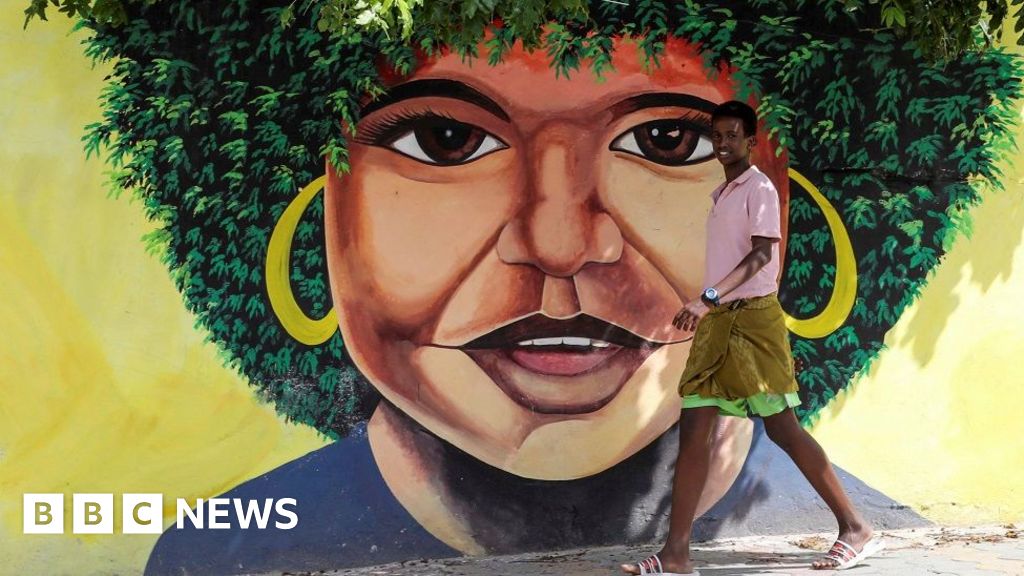Trees, tresses and teamwork: Africa's top shots

Africa in Pictures: Murals, Music, and Milestones Across the Continent
From vibrant murals in Mogadishu to the stage at Lollapalooza in Paris, a collection of striking images this week captures the diverse tapestry of life across the African continent. The photographs offer glimpses into cultural celebrations, sporting achievements, and the everyday realities shaping communities from North to South.
A Visual Journey Through Africa
The selection showcases a range of subjects, reflecting the dynamism and challenges faced by African nations. Among the highlights:
A mural in Mogadishu, Somalia, where branches frame a colorful depiction of local life. Guinean athlete Alexandra Mansare-Traoré competing at the World Aquatics Championships in Singapore, representing the growing presence of African athletes on the global stage. Nigerian singer Tems performing at Lollapalooza in Paris, highlighting the increasing international recognition of African music and artists. Kenyan bodybuilders training in Nairobi's Mathare neighborhood, a testament to the dedication and resilience within informal settlements. Celebration by Ghanaian footballers at the Women's Africa Cup of Nations, underscoring the rising profile of women's sports in Africa. Scenes from the annual horse race in Lesotho, a cultural event following the King's birthday. Participants in Morocco's Ahidous National Festival, preserving Amazigh traditions through storytelling, music, and games. The presentation of an honorary PhD to South African politician Malusi Gigaba, acknowledging contributions to public management and governance. Images of dilapidated buildings in Alexandria, Egypt, highlighting the impact of rising sea levels and coastal erosion. Construction of new homes in Nairobi, Kenya, reflecting urbanization and development efforts. Families returning to Sudan from Egypt after fleeing the civil war, illustrating the complex realities of displacement and return. Anti-corruption protests in Banjul, Gambia, demonstrating the growing demand for accountability and good governance. Moroccans marching in solidarity with Palestinians in Gaza, reflecting regional and international concerns. The unveiling of a Nelson Mandela mural in Cape Town, South Africa, commemorating Mandela Day and his legacy. Young men in South Africa's Limpopo province returning home after a rite of passage, showcasing traditional cultural practices.
The Power of Visual Storytelling
These images, captured by photographers from various agencies including Reuters, Getty Images, and AFP, offer a powerful snapshot of Africa's multifaceted identity. They transcend geographical boundaries, inviting viewers to connect with the continent's diverse cultures, challenges, and triumphs.
Expert Perspective: The Role of Photography in Shaping Perceptions of Africa
Dr. Fatima Diallo, a professor of African Studies at the University of Dakar, emphasizes the importance of diverse visual representation. "For too long, images of Africa have been dominated by narratives of conflict and poverty," she explains. "While these realities exist, they do not represent the entirety of the African experience. It is crucial to showcase the continent's innovation, creativity, and resilience to counter these stereotypes and foster a more nuanced understanding." She further adds, "The rise of African photographers and visual artists is particularly significant, as they offer authentic perspectives that challenge external narratives."
Context: Shifting Narratives and the Rise of African Voices
Historically, Western media has often portrayed Africa through a lens of crisis and dependence. However, there is a growing movement to decolonize the narrative and amplify African voices. This includes increased investment in local media, the rise of African photographers and filmmakers, and a conscious effort to showcase the continent's achievements in various fields, from technology and innovation to arts and culture.
The Importance of Contextualizing Images
Professor Kwame Nkrumah, a media analyst based in Accra, Ghana, cautions against viewing images in isolation. "It is essential to provide context and background information to avoid misinterpretations and stereotypes," he says. "For example, an image of a crowded market should be accompanied by information about the local economy, trade practices, and cultural significance of the market." He emphasizes the need for responsible journalism that avoids sensationalism and promotes a balanced and informed understanding of Africa.
The selected images, while diverse in subject matter, contribute to a broader effort to present a more complete and accurate picture of Africa – a continent of immense potential, rich cultural heritage, and ongoing progress.
Originally sourced from: BBC News Africa
